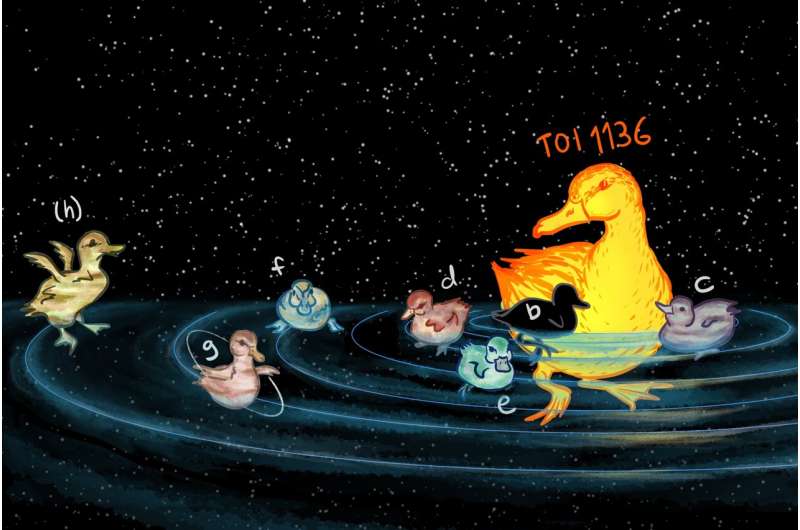Analysis of Masses, Orbital Properties, and Atmospheric Features of Six Exoplanets by Astronomers

January 26, 2024
The following article has undergone a thorough examination based on Science X's established editorial process and policies. The article's credibility has been ensured through the following attributes:
- Fact-checking
- Peer-review
- Reliance on trusted sources
- Proofreading
by the University of California, Irvine.
Recently, a solar system with six confirmed exoplanets and potentially a seventh discovered has expanded our understanding of planetary evolution and formation. Researchers at the University of California, Irvine, heading a team utilizing a variety of instruments and observatories globally, have obtained the most accurate measurements yet of these exoplanets' masses, orbits, and atmospheres.
Today, findings from the TESS-Keck Survey were published in The Astronomical Journal, offering a detailed description of the exoplanets orbiting TOI-1136, a dwarf star located in the Milky Way galaxy, over 270 light years away. In 2019, initial observations of these exoplanets were made using data from the Transiting Exoplanet Survey Satellite, allowing for the first estimation of the exoplanets' masses using transit timing variations, which is a measure of the gravitational tug that planets orbiting one another exert.
In the most recent study, researchers combined the TTV data with a radial velocity study of the star, using the Automated Planet Finder telescope at the Lick Observatory on Mount Hamilton, California, and the High-Resolution Echelle Spectrometer at the W.M. Keck Observatory on Mauna Kea, Hawaii. These tools enabled the detection of slight changes in the star's motion due to the Doppler effect's redshift and blueshift, allowing for unprecedented precision in determining planetary masses.
The team established computer models using hundreds of radial velocity measurements on top of the TTV data to gather precise information on the planets in this solar system. Corey Beard, lead author and UCI Ph.D. candidate in physics, commented that merging these two types of data yielded more insight about the system than previously available.
'Much trial and error was involved, but we are very pleased with our results subsequent to developing one of the most convoluted planetary system models in exoplanet literature to date,' said Beard.
Co-author Paul Robertson, UCI associate professor of physics & astronomy, mentioned that the system's large number of planets is part of the reason the astronomy team decided to further investigate.
'TOI-1136 seemed like an excellent opportunity for research because systems with multiple exoplanets allow us to compensate for the effects of planet evolution that depend on the host star. This approach lets us focus on distinct physical mechanisms that resulted in these planets having their specific properties,' commented Robertson.
He explained that comparing planets in different solar systems is challenging due to the distinct properties of stars and their disparate locations in the galaxy. Studying exoplanets within the same system allows for the examination of planets with shared histories.
At only 700 million years old, TOI-1136 is young for a star, which intrigues exoplanet researchers. Robertson mentioned that these fledgling stars are demanding and unique to study as they exhibit heightened magnetism, sunspots, and solar flares. This radiation impacts and shapes planets, altering their atmospheres.
The confirmed exoplanets, TOI-1136 b through TOI-1136 g, are classified as 'sub-Neptunes.' According to Robertson, the smallest planet is double Earth's radius, while others are up to four times as large, similar to Uranus and Neptune.
All planets orbit TOI-1136 in a period shorter than the 88 days it takes Mercury to orbit our sun. 'We're fitting an entire solar system into a region around the star so small that our entire planetary system would be outside of it,' said Robertson.
Co-author Rae Holcomb, a UCI Ph.D. candidate in physics said, 'They're unusual planets to us since we don't have anything identical to them in our solar system. However, as we continue to study other planetary systems, these may turn out to be the most prevalent type of planet in the galaxy.'
This solar system has an unusual characteristic - it potentially contains a seventh planet. The team detected evidence of another gravitational force in the system. Robertson explained how when planets orbit closely, they can gravitationally impact one another.
'When you hear a chord played on a piano and it sounds good to you, it's because there is resonance, or even spacing, between the notes that you're hearing,' he said. 'The orbital periods of these planets are spaced similarly. When the exoplanets are in resonance, the tugs are in the same direction every time. This can have a destabilizing effect, or in special cases, it can serve to make the orbits more stable.'
Robertson noted that far from answering all his team's questions about the exoplanets in this system, the survey has made the researchers want to pursue additional knowledge, particularly about the composition of planetary atmospheres. That line of inquiry would be best approached through the advanced spectroscopy capabilities of NASA's James Webb Space Telescope, he said.
'I am proud that both UCO's Lick Observatory and the Keck Observatories were involved in the characterization of a really important system,' said Matthew Shetrone, deputy director of UC Observatories. 'Having so many moderate-sized planets in the same system really lets us test formation scenarios. I really want to know more about these planets! Might we find a molten rock world, a water world and an ice world all in the same solar system? It almost feels like science fiction.'
Journal information: Astronomical Journal , arXiv
Provided by University of California, Irvine




